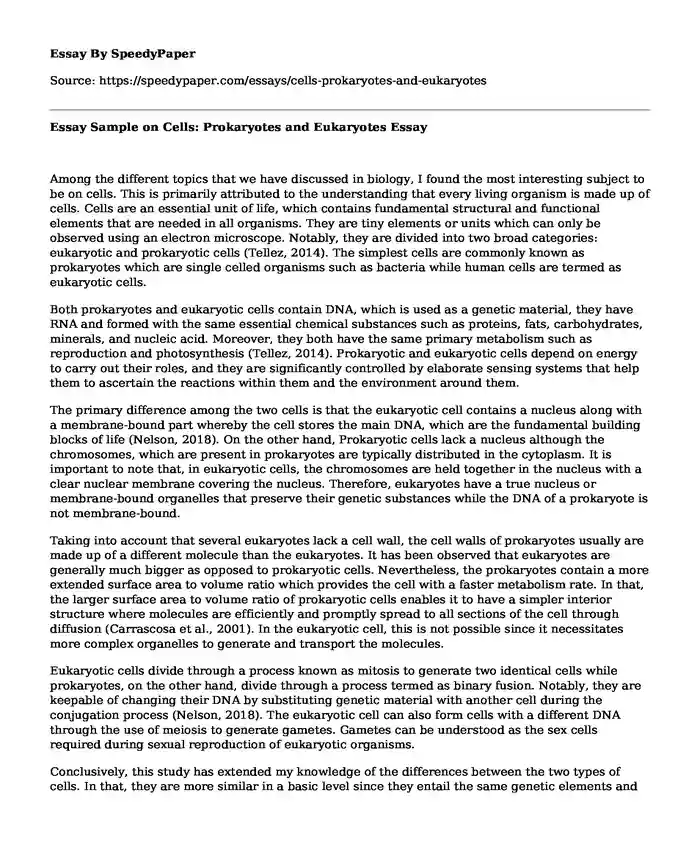Among the different topics that we have discussed in biology, I found the most interesting subject to be on cells. This is primarily attributed to the understanding that every living organism is made up of cells. Cells are an essential unit of life, which contains fundamental structural and functional elements that are needed in all organisms. They are tiny elements or units which can only be observed using an electron microscope. Notably, they are divided into two broad categories: eukaryotic and prokaryotic cells (Tellez, 2014). The simplest cells are commonly known as prokaryotes which are single celled organisms such as bacteria while human cells are termed as eukaryotic cells.
Both prokaryotes and eukaryotic cells contain DNA, which is used as a genetic material, they have RNA and formed with the same essential chemical substances such as proteins, fats, carbohydrates, minerals, and nucleic acid. Moreover, they both have the same primary metabolism such as reproduction and photosynthesis (Tellez, 2014). Prokaryotic and eukaryotic cells depend on energy to carry out their roles, and they are significantly controlled by elaborate sensing systems that help them to ascertain the reactions within them and the environment around them.
The primary difference among the two cells is that the eukaryotic cell contains a nucleus along with a membrane-bound part whereby the cell stores the main DNA, which are the fundamental building blocks of life (Nelson, 2018). On the other hand, Prokaryotic cells lack a nucleus although the chromosomes, which are present in prokaryotes are typically distributed in the cytoplasm. It is important to note that, in eukaryotic cells, the chromosomes are held together in the nucleus with a clear nuclear membrane covering the nucleus. Therefore, eukaryotes have a true nucleus or membrane-bound organelles that preserve their genetic substances while the DNA of a prokaryote is not membrane-bound.
Taking into account that several eukaryotes lack a cell wall, the cell walls of prokaryotes usually are made up of a different molecule than the eukaryotes. It has been observed that eukaryotes are generally much bigger as opposed to prokaryotic cells. Nevertheless, the prokaryotes contain a more extended surface area to volume ratio which provides the cell with a faster metabolism rate. In that, the larger surface area to volume ratio of prokaryotic cells enables it to have a simpler interior structure where molecules are efficiently and promptly spread to all sections of the cell through diffusion (Carrascosa et al., 2001). In the eukaryotic cell, this is not possible since it necessitates more complex organelles to generate and transport the molecules.
Eukaryotic cells divide through a process known as mitosis to generate two identical cells while prokaryotes, on the other hand, divide through a process termed as binary fusion. Notably, they are keepable of changing their DNA by substituting genetic material with another cell during the conjugation process (Nelson, 2018). The eukaryotic cell can also form cells with a different DNA through the use of meiosis to generate gametes. Gametes can be understood as the sex cells required during sexual reproduction of eukaryotic organisms.
Conclusively, this study has extended my knowledge of the differences between the two types of cells. In that, they are more similar in a basic level since they entail the same genetic elements and they both respire to produce energy. Anatomically, I was able to understand that prokaryotic cells resemble specific eukaryotic organelles such as chloroplast and mitochondria as opposed to the eukaryotic cell itself. However, putting them in the perspectives of essentials for life, they both operate similarly.
References
Carrascosa, J., Llorca, O., & Valpuesta, J. (2001). Structural comparison of prokaryotic and eukaryotic chaperoning. Micron, 32(1), 43-50. Doi: 10.1016/s0968-4328(00)00027-5.
Nelson, D. (2018). The difference between Eukaryotic and Prokaryotic Cells. Science Trends. doi:10.31988/scitrends.20655.
Tellez, G. (2014). Prokaryotes versus Eukaryotes: Who is Hosting Whom? Frontiers in Veterinary Science, 1. doi:10.3389/fvets.2014.00003.
Cite this page
Essay Sample on Cells: Prokaryotes and Eukaryotes. (2022, Sep 23). Retrieved from https://speedypaper.net/essays/cells-prokaryotes-and-eukaryotes
Request Removal
If you are the original author of this essay and no longer wish to have it published on the SpeedyPaper website, please click below to request its removal:
- Free Essay Example: To Write. To Read. To Live
- Essay Sample Containing the Admission Statement
- Impact of Japanese Earthquake
- Book Review Essay Sample on My Sister's Keeper
- Essay Example: The Role of Music in Movies by Bridgette Redman
- Free Essay on Serving Veterans as a Mental Health Nurse
- Free Essay Focusing on Early Childhood Education Program
Popular categories





